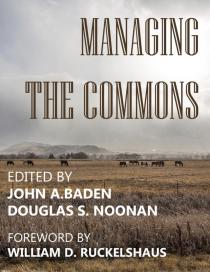Managing the Commons
Synopsis
Managing natural resources that are held in common is a great and grave challenge. It requires addressing the community of users, beneficiaries, and managers. It also requires consideration of how those communities interact with the commons itself. At stake is the prosperity, and even survival, of both the people and the environment.
Understanding and improving how we relate to commons has been the focus of much scholarly and practical research in the last 30 years. A quick look at the various natural resource commons surrounding us indicates that
this will no doubt continue.
Pacific Northwest salmon fisheries represent a system of commons, both complex and illustrative. My past history as administrator of the US. Environmental Protection Agency and my fisherman’s interest in salmon has heightened my sensitivity to the plight of the salmon and the people whose lives they affect. Recently, my wife and I moved back to the Pacific North-west—something the salmon try to do every year as they live out their
inspiring life cycles. Unlike us, the salmon do not always find a hospitable environment when they return. There are many reasons: Simply put, there are more people in the salmon’s way, and they struggle more with the problems that come with expanding human populations. A number of reports issued over the past few years have chronicled the broad declines and local extinction of many salmon, steelhead, and sea-run cutthroat stocks in the
region. The people who fish for a living and the communities in which they live have been hit hard. Our resource agencies are in danger of being overwhelmed by the complexity and magnitude of the problem.
Why are salmon faring so poorly? Who is responsible? What can be done to reverse the recent declines in salmon populations? When tragedy befalls a commons as it has the salmon, I come to no conclusion about who is at
fault, and I don’t intend to. The one thing that I am certain of is that the only truly innocent parties in all of this are the salmon and the generations of people yet to come. It seems to me that the responsibility falls upon all of us—fishermen, resource managers, and concerned citizens alike—to take the steps necessary to ensure that salmon populations recover to the point that our children will be able to enjoy the quality of life we once took for granted.
While many people focus on how to get the most from commons, groups like the Sustainable Fisheries Foundation emphasize providing and maintaining those natural resources. Their goal is deceptively simple: â€We are trying to put more salmon back in the rivers and lakes of the Pacific Northwest.†Determining exactly how to accomplish this goal has defied the efforts of a great many dedicated and talented people.
Many papers and panel discussions, especially reports on the status and trend ofwild salmon populations in the North Pacific, make it clear that many salmon stocks in parts of the lower United States, southern British Columbia, and the west coast of Vancouver Island are not faring well. The decline in salmon numbers in these areas corresponds with a rapidly expanding human population, alterations in land and water use, increasing sediment and containment loads, and heavy fishing pressure by a combination of sport,
commercial, and tribal groups.


